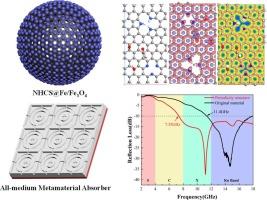Breaking bandwidth limit: All-medium metamaterial absorber engineered from heterostructure-anchored N-doped hollow carbon spheres
IF 13.2
1区 工程技术
Q1 ENGINEERING, CHEMICAL
引用次数: 0
Abstract
The composition and structural characteristics of materials significantly influence their ability to absorb electromagnetic waves (EMW). In this research, iron-based heterostructure particles were effectively attached to N-doped hollow carbon spheres (NHCS) through straightforward electrostatic assembly and heat treatment processes, creating a novel composite material (denoted as NHCS@Fe/Fe₃O₄). For samples treated at different annealing temperatures, we use suffixes (e.g., NHCS@Fe/Fe₃O₄-700) to distinguish the specific conditions. This method notably improves the impedance matching characteristics of the as-prepared composites so as to enhance theirs EMW absorption capacity. The effect of NHCS diameter on EMW absorption performance was systematically investigated, and the product, NHCS@Fe/Fe₃O₄-700, with a diameter of 200 nm, exhibited exceptional EMW absorption properties, achieving a minimum reflection loss (RL) of −55.06 dB at 15.12 GHz and an effective absorption bandwidth (EAB) of 6.59 GHz at a matching thickness of 2.37 mm. Additionally, density functional theory (DFT) calculations were conducted to study the electronic properties and polarization behaviors within the NHCS. And an all-medium metamaterial absorber, made up of multi-layered open-ring configuration, was realized through CST simulations, successfully expanding the effective absorption frequency range. Radar cross-section (RCS) simulations further confirmed the application potential of as-prepared composite in real-world. This investigation provides a meaningful perspective and paves a fast route for developing high-performance EMW absorption materials.

突破带宽限制:由异质结构锚定氮掺杂空心碳球设计的全介质超材料吸收体
材料的组成和结构特性对其吸收电磁波的能力有很大的影响。在这项研究中,铁基异质结构颗粒通过简单的静电组装和热处理工艺有效地附着在n掺杂中空碳球(NHCS)上,创造了一种新的复合材料(表示为NHCS@Fe/Fe₃O₄)。对于在不同退火温度下处理的样品,我们使用后缀(例如,NHCS@Fe/Fe₃O₄-700)来区分具体情况。该方法显著改善了复合材料的阻抗匹配特性,从而提高了复合材料的EMW吸收能力。系统研究了NHCS直径对EMW吸收性能的影响,产物NHCS@Fe/Fe₃O₄-700直径为200 nm,具有优异的EMW吸收性能,在15.12 GHz处的最小反射损耗(RL)为−55.06 dB,在匹配厚度为2.37 mm处的有效吸收带宽(EAB)为6.59 GHz。此外,通过密度泛函理论(DFT)计算研究了NHCS内部的电子性质和极化行为。通过CST模拟,实现了多层开环结构的全介质超材料吸波器,成功地扩大了有效吸收频率范围。雷达截面(RCS)模拟进一步证实了该复合材料在现实世界中的应用潜力。该研究为开发高性能EMW吸收材料提供了有意义的前景,并为开发高性能EMW吸收材料铺平了快速途径。
本文章由计算机程序翻译,如有差异,请以英文原文为准。
求助全文
约1分钟内获得全文
求助全文
来源期刊

Chemical Engineering Journal
工程技术-工程:化工
CiteScore
21.70
自引率
9.30%
发文量
6781
审稿时长
2.4 months
期刊介绍:
The Chemical Engineering Journal is an international research journal that invites contributions of original and novel fundamental research. It aims to provide an international platform for presenting original fundamental research, interpretative reviews, and discussions on new developments in chemical engineering. The journal welcomes papers that describe novel theory and its practical application, as well as those that demonstrate the transfer of techniques from other disciplines. It also welcomes reports on carefully conducted experimental work that is soundly interpreted. The main focus of the journal is on original and rigorous research results that have broad significance. The Catalysis section within the Chemical Engineering Journal focuses specifically on Experimental and Theoretical studies in the fields of heterogeneous catalysis, molecular catalysis, and biocatalysis. These studies have industrial impact on various sectors such as chemicals, energy, materials, foods, healthcare, and environmental protection.
 求助内容:
求助内容: 应助结果提醒方式:
应助结果提醒方式:


